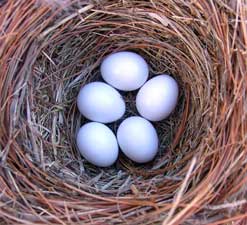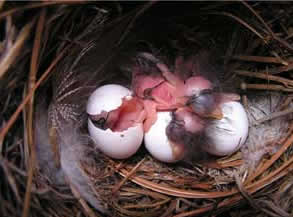Bluebird eggs are blue, right? Not always! Up to 4-5% of bluebirds lay white eggs.




White eggs can occur in all three species (Eastern, Mountain and Western Bluebirds), although they may be more unusual in Mountain Bluebirds(?)
- White eggs may look pure white, or have a slightly pink hue or blue tinge (i.e., very pale blue).
- Normally, color (pigment) is added to the eggshell from cells/glands in the wall of the female’s oviduct (the passage along which eggs travel). This does not happen with white eggs.
- The entire clutch will be white. If you find blue eggs mixed with white in the same nest, it probably means eggs were dumped by another female.
- A female that lays white eggs will apparently always lay white eggs. (Although Kridler speculates that if the coloration was due to an infection in the pigment gland and it cleared up, the female would resume laying blue eggs.) Therefore, if the eggs in the first brood in a nestbox are white, and the eggs in the second brood in the same nestbox are blue, a different female is involved.
- White eggs are as fertile as blue eggs.
- White eggs produce normal colored offspring (i.e., the nestlings are not albinos or leucistic.) Normally colored females lay white eggs.
- Percentages of eggs that are white vary, and since the trait appears to be genetic, would be dependent on local populations.
- 1997 The Birdhouse Network data: 4.3% of all the bluebird clutches reported were white.
- 1998 The Birdhouse Network data: 4.5% were white, with 1.7% clutches having both blue and white eggs (suggesting egg dumping).
- Lasky (1939, Bird Banding 10:24) reported that 9.1% of all Eastern Bluebird eggs were white.
- TE Musselman (1935) reported that 5.48% of eggs were white.
- Sometimes blue bluebird eggs have just a bit of white streaks or markings that look like scratches. ?Maybe they are from urine/droppings/blood stuck on the eggs, or from irregular pigment application during development, or from the female turning the eggs?
- Note that Tree Swallows lay pure white eggs, but they are smaller and more pointy than bluebird eggs. If you find white eggs with speckles (brown, red, etc.) suspect another species.
- See other Bluebirding Myths.

GENETICS AT WORK?
Laying white eggs is believed by some to be genetic (i.e., an inherited trait), associated with the female. It does not appear that there is enough evidence yet to prove this is the case. If laying white eggs were genetic, it would not be unusual to see them repeatedly over time in the same geographic area, as some studies have shown that 30% of bluebirds return to previous nesting sites the following season, or conversely to hardly ever see them in a certain geographic area.
-
TE Musselman (1935), who banded birds, noted a case in which a young female that had developed from a white egg also laid white eggs.
-
Briggs (1902) collected 5 sets of pure albino eggs from the same pair of Eastern Bluebirds.
-
Wayne (1910) also reported 3 sets of white eggs from a single pair.
-
However, Lasky reported that some banded daughters and granddaughters of a white-egg-laying female laid normally colored eggs. Another female that hatched from a blue egg laid white eggs. (Bent)
“expressed” when the dominant blue gene is not present (like blue vs. brown eyes in humans)? – i.e., both the male and the female have to carry the gene to pass it to their offspring, and even then, there would only be a 25-50% chance that the offspring would also lay white eggs. See charts below that show the possible odds of having a white egg (assuming a single gene is involved) if this is the case. Only a bird with the ww genes would lay a white egg. This (probably too simplistic) theory remains to be tested, requiring banding of multiple generations or DNA testing. It is also complicated by extra-pair matings, as up to a third of the young in a nest might be sired by a different male.
|
ODDS OF WHITE EGGS IF TRAIT IS INHERITED AND RECESSIVE
|
|||||||||||||||||
|
B=dominant Blue gene
w=recessive white gene |
|||||||||||||||||
| Female lays blue eggs, 25% of offspring will lay white eggs | Female lays white eggs, 50% of offspring will lay white eggs | ||||||||||||||||
|
|
||||||||||||||||
| Female lays blue eggs, none of offspring will lay white eggs | Female lays white eggs, 100% of offspring will lay white eggs | ||||||||||||||||
|
|
||||||||||||||||
| Female lays blue eggs, 75% of offspring will lay white eggs | Female lays white eggs, none of offspring will lay white eggs | ||||||||||||||||
|
|
||||||||||||||||
- Others suggest that an albino egg is due to a temporary physiological disturbance or malfunction of the glands in the oviduct. I.e., a female that lays white eggs could have a blockage of the duct that carries the blue color, or an infection which damaged the duct.
- Perhaps it could also be the result of a birth defect (not necessarily inherited) that affects the pigment carrying gland.
References and More Information:
- Munroe Hugh L, et al., 1980, Fertility of Albinistic Eggs in Mountain Bluebirds, Auk Volume 98, p.181-182
- Musselman, T.E., 1935, Three Years of Eastern Bluebird Banding and Study, Bird-Banding, 6: 117-125.
- A.C. Bent, Familiar Histories of North American Birds, Eastern Bluebird
- Genetics of egg shell color (chickens). Note: In chickens, the blue gene is dominant over white. Chickens with one blue gene and one recessive white gene may lay eggs that are lighter blue. The blue eggshell pigment, oocyanin, is a byproduct of bile formation and is present throughout the eggshell.
- Photo of pink bluebird eggs
- Photos of nests, eggs and young: Eastern Bluebird | Mountain Bluebird | Western Bluebird
- Weird eggs
- See another white egg photo from my trail
- Widows/Widowers
- Dissection photo showing egg production in a House Sparrow
- Nest and Egg ID, Bios by Species
- Why didn’t the eggs hatch?
- I found an egg – can I incubate it?
- How many broods will a bluebird have in a season?
- When will the first egg be laid?
- Supplementing Calcium – Feeding Chicken Eggshells, etc. to Birds
Clouds come floating into my life, no longer to carry rain or usher storm, but to add color to my sunset sky.
– Rabindranath Tagore, Stray Birds
